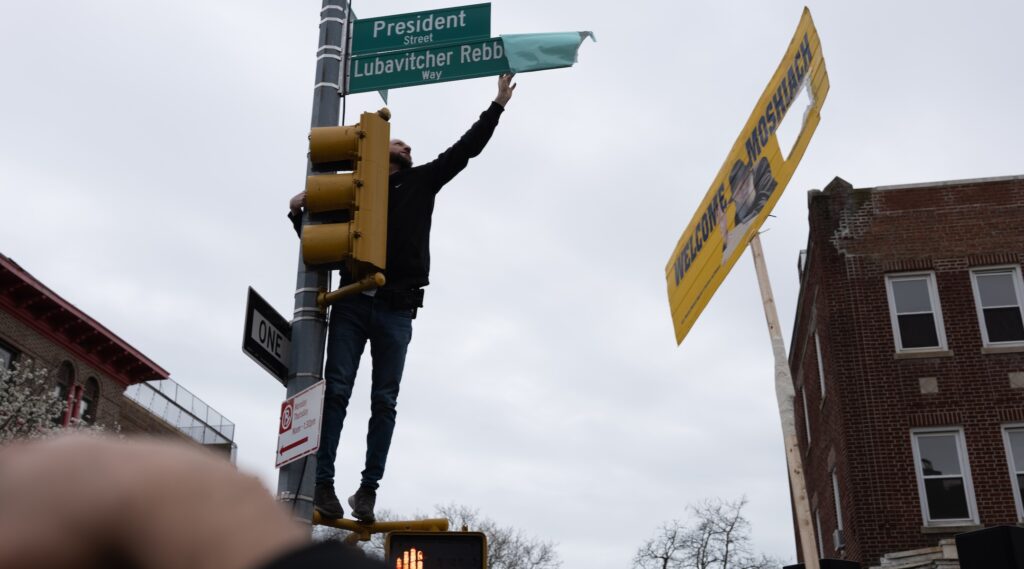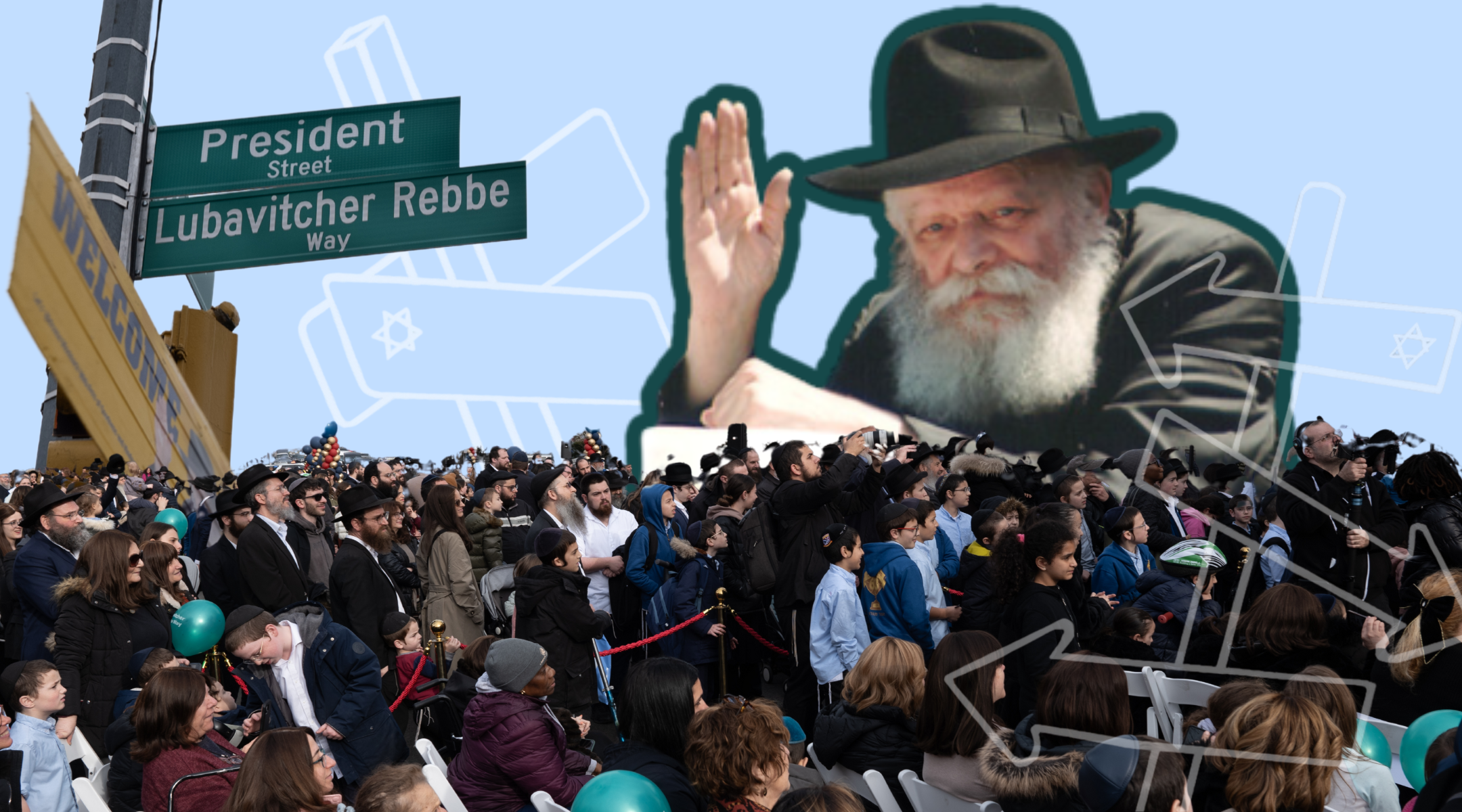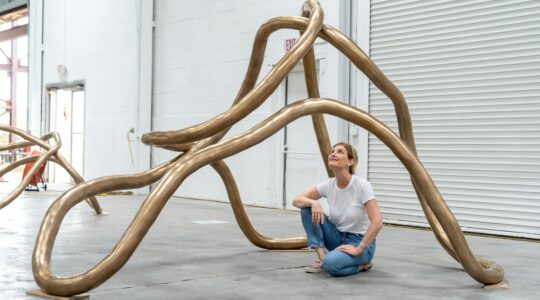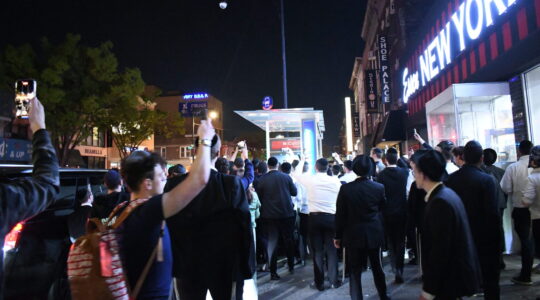It was an unexpectedly sunny Sunday afternoon in Brooklyn, and hundreds of people — mostly members of the Chabad-Lubavitch movement — had gathered on President St. for a joyful celebration.
It wasn’t a Jewish holiday, however, nor was it a celebration of a simcha like a bar mitzvah or wedding. Rather, the community had assembled to mark the unveiling of a newly co-named stretch of street: Lubavitcher Rebbe Way.
The new street sign is located at the corner of President St. and Brooklyn Ave., down the street from the house, at 1304 President St., where Rabbi Menachem Mendel Schneerson — also known as the Lubavitcher Rebbe — lived with his wife, Rebbetzin Chaya Mushka Schneerson. Schneerson was the Chabad-Lubavitch movement’s leader from 1951 until his death in 1994, and remains a towering figure in Chabad Jewish life.
“At a time when antisemitism is as prevalent as it is today, it is crucial for people of all backgrounds and experiences to stand together to honor the vast contributions of the Jewish Diaspora — including the everlasting impact of the Rebbe, here in New York and across the world,” said Crystal Hudson, the City Council member for Crown Heights and surrounding areas, who initially introduced the proposal for the co-naming last year.
Born in 1902 in current-day Ukraine, Schneerson and his wife moved to Berlin in 1928, escaping in 1933 after the Nazis’ rise to power. The couple then fled Nazi-occupied France in 1941 before arriving in New York. A decade later, Schneerson’s father-in-law, Rabbi Yosef Yitzchak Schneersohn, died, and Schneerson assumed his title of rebbe.
Under the younger Schneerson’s leadership, the Chabad movement transformed into a global network of outreach centers to observant and non-observant Jews, and has continued growing in the three decades since his death. Chabad has not had a rebbe after Schneerson — the seventh rebbe of the movement, which was founded in the 18th century in the Russian Empire — which at times has led to divisions among the rank-and-file. During his lifetime, and afterwards, the movement’s headquarters at 770 Eastern Parkway in Crown Heights has become a required stop for politicians seeking the community’s vote.
Given Schneerson’s legacy — and given that New York City has more than 2,500 streets and other locations named for notables — it is perhaps surprising that it’s taken more than 30 years since his passing for a street to be named in Schneerson’s honor. (Then again, the process of co-naming a street is “always a fight,” Curbed wrote last year.)
Rabbi Yaacov Behrman, a Chabad PR liaison who Hudson said “led the charge” in renaming the street, said he thinks this is in part because of Chabad’s focus on external outreach. “I don’t think it’s the way people think in this neighborhood,” Behrman said. “They think about another Chabad house, another synagogue, another Pesach seder in another country. I don’t think anybody thought about it, it’s that simple.”
Behrman, 42, added that he grew up in a house from which he could see the Schneersons’, and would watch the Rebbe’s car pull into the driveway and see the light turn on in his study.
“But a lot of the younger generation, they grew up only with 770,” Behrman said, where Schneerson moved after his wife’s death in 1988. “They were not old enough to really remember how critical the house was, how the house was the foundation for everything.”
Behrman said he thinks the Rebbe’s house has become more heavily visited in recent years. And last summer, on the 30th anniversary of the Rebbe’s death — the same day that 50,000 people visited Schneerson’s gravesite in Queens, known as the Ohel — Behrman decided to reach out to Hudson, the neighborhood’s council member, about co-naming the block where that house stands.
According to Behrman, Hudson “said she was on board right away.”
The co-naming also had the support of the local New York State Senator Zellnor Myrie, who is running as a Democrat for mayor. Myrie had sponsored a bill last month honoring Schneerson upon the co-naming and extolled Schneerson at the state Senate last week. (In 2019, he introduced a bill honoring Schneerson’s birthday, on the 11th of Nissan on the Hebrew calendar.)
On Sunday, the ceremony kicked off with a singing of “God Bless America” before speeches were delivered by Behrman, followed by a number of elected officials.
New York City Mayor Eric Adams, who is running for reelection as an independent and whose approval rating has hit record lows, received perhaps the loudest applause of all the speakers.
“During the most difficult days of my life — not only as mayor but also as borough president — I’ve found my way to the Grand Rebbe’s grave,” Adams said. Adams has visited the site at least six times.
Schneerson’s “tremendous influence and impact can be seen and felt across our entire city,” said Council Speaker Adrienne Adams, who is also running for mayor and is not related to Eric Adams. “Under his leadership, Chabad houses in every corner of New York are spreading their light and kindness to support our residents, from educational to religious institutions and beyond.”
Myrie took the opportunity to remark on the weather, which had brightened considerably before the 4:30 p.m. event. “Look at the divine order that the clouds would split and the sun would shine on this community on this day,” he said.

One limber attendee climbed up to the top of the traffic light, then uncovered the remainder of the brand-new street sign after its wrapping had ripped. (Joseph Strauss)
Some speakers also did their best to relate to the heavily Hasidic crowd.
“Ma nishma?” Public Advocate Jumaane Williams said as he took the mic, using the Hebrew expression for “what’s up?” He also called the crowd his “mishpocha,” or “family,” in Yiddish.
“I’m not Lubavitch, but my Hebrew name is Menachem, so I’ve got street cred here,” said Manhattan borough president Mark Levine, who is running to be City Comptroller and who put on tefillin following the ceremony. (That’s something that did not happen after the co-naming of Beastie Boys Square on the Lower East Side.)
Finally, after about an hour of speeches — including remarks from Attorney General Letitia James and Brooklyn Borough President Antonio Reynoso — the hundreds who’d gathered migrated from in front of Schneerson’s house to the corner of the block, where the street sign would be unveiled.
The proceedings hit a snag when, while attempting to unveil the brand-new sign, its wrapping ripped, leaving half of it still covered. Thankfully, one limber and quick-thinking attendee, Joel Gross, rose to the occasion by climbing up to the top of the traffic light and uncovering the remainder of the sign, prompting an eruption of cheers.
“They couldn’t take it down, I helped,” Gross told the New York Jewish Week afterwards, laughing.
Klezmer music blasted from speakers along the block and schmoozing ensued. And while the vibes on Sunday resembled something of a block party, residents said their newly named street will have a lasting impact.
“I feel a very big privilege, to live from President Street to live now on Lubavitcher Rebbe Way,” said Mendel Sperlin, 17, whose family lives on the block. “Now we could maybe try to act a little in the Rebbe’s way.”
The New York Jewish Week brings you the stories behind the headlines, keeping you connected to Jewish life in New York. Help sustain the reporting you trust by donating today.





